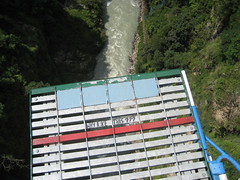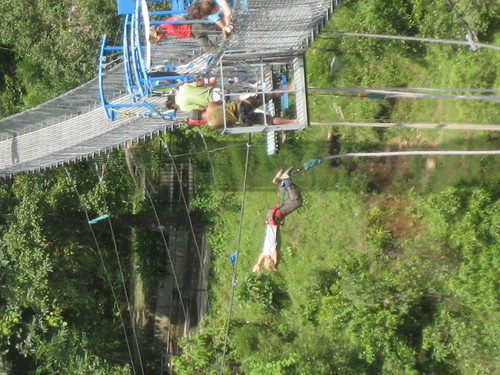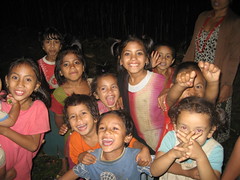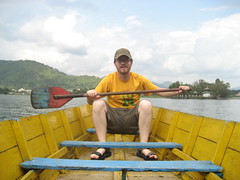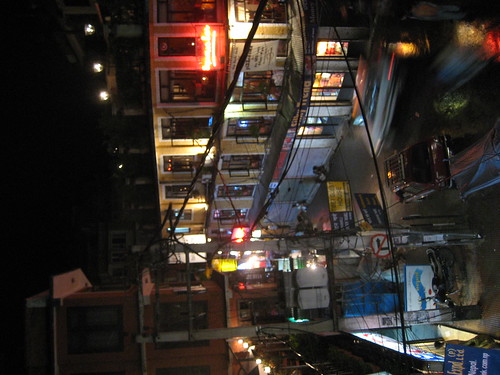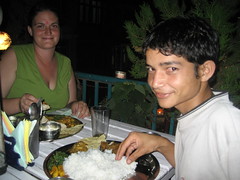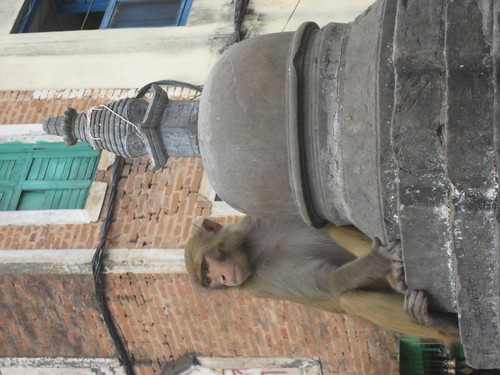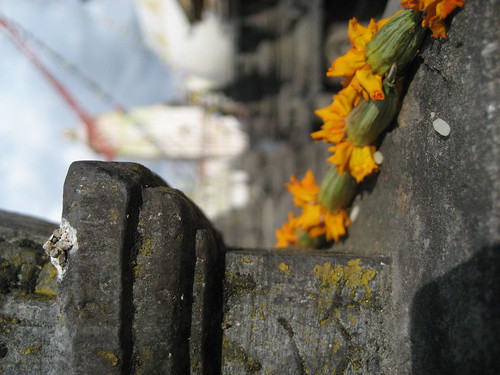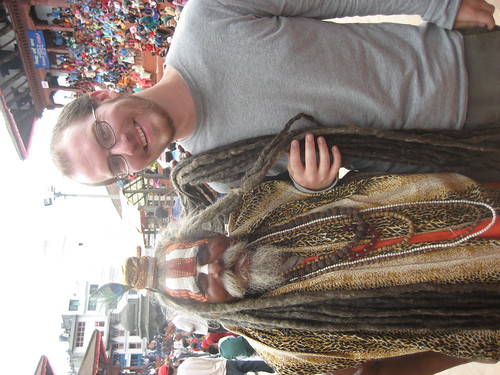Tales of Teahouse Trekking
It’s been almost two weeks since the last update, so be warned that this one is a bit long.
I started my trek at Baglung Buspark on the north side of Pokhara where I boarded a bus packed with people. Since few people in Nepal own cars and home delivery services are virtually non-existent, buses serve as the only means to move around people’s stuff. Buying a microwave? Bring it on the bus! Buying a new couch? Bring it on the bus! Added to that, people are squeezed into every nook and cranny inside and outside the bus — it is normal to see a handful of people sitting on the roof and a few hanging off the sides. As a result, buses look like a cross between the stock room at Costco and the inside of a crowded elevator.
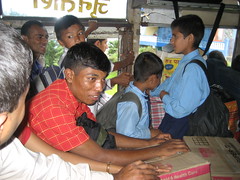
I quickly made friends with my bus-mates, and got chatting with Manadutta, a squirrely, fast-talking teacher at an English-speaking school along the bus route. As his stop approached, he invited me to come stay with his family for the night and talk to his class in the morning so they could converse with a native English speaker. I hesitated for a minute, then decided just to go for it, trek schedule be damned. We walked from the bus stop in Khare village toward his modest one-bedroom apartment with an outdoor bathroom shared by a few other units. I was greeted by his family, who all make the tiny apartment home: his wife, mother-in-law, 7-year-old niece, and two young sons. They were a lot happier than this in real life:
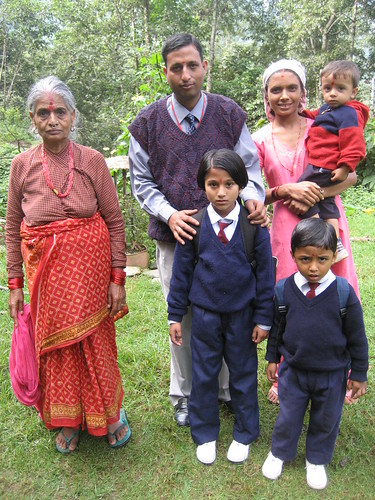
I spent the night sitting with the family, helping the kids with their homework, and watching TV, which was interrupted every fifteen minutes by frequent power outages. I spent some time with Manadutta and his teacher friend Krishna talking about the Nepali caste system, and he proudly informed me that they are from the Brahmin caste, the highest and most respected of the four caste levels. I asked them if they associate with people of other castes — having them over for dinner, for example. “Of course we can,” they said, which relieved me a bit that the caste system isn’t as restrictive as I previously thought. They quickly added, “but they can’t eat our food or touch anything.” Oh, I see.
After speaking to the teachers for a bit, we all sat on the floor and were served a massive dinner of dal baht — essentially rice topped with lentil soup — on a platter the size of a hubcap. Trying my hardest not be rude I made it my goal to finish the absurd amount of rice, but after more than an hour of constant rice-eating my stomach felt like it was going to explode and I had to give up. The rest of the family finished their enormous portions without a problem and looked at me like I was an idiot.
The next morning, we headed with the kids to Manadutta’s school, and it was quickly clear that I was in way over my head. A school-wide assembly was called for my presence, and the few hundred uniformed students lined up in rows outside to wait for their special guest of honor: me. I’m normally fairly comfortable talking in front of people, but I was totally out of my element. I had about ten seconds to scrape together something to say before I was shuffled in front of the mass of kids between the ages of 4 and 16. My glorious self-introduction went something like this: “Hi... um... I’m Ryan... and um... I’m from... uh... America.” Cue the chirping crickets.
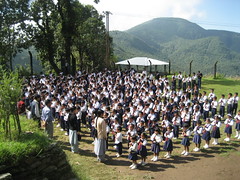
A few awkward moments aside, I managed to talk for about fifteen minutes about traveling, each member of my family, my hobbies, what I did back in school and at work, and most importantly how much I love Nepal. The kids seemed fairly interested and laughed a couple of times at my lame off-the-cuff jokes. After my speech, Manadutta took me to speak to his 10th grade class, which was much more my speed. The kids spoke great English, and it was really fun getting to talk to them for an hour or so. I left the school and boarded the bus again to finally start my trek at the nearby village of Naya Pul.
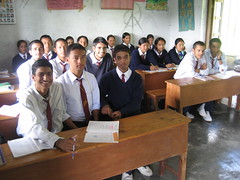
Over the course of ten days my planned trek would take me from Naya Pul to the holy city of Muktinath, which is the easier and more luxurious half of the famous 3-week Annapurna Circuit trek. Trekking here is a bit unusual compared to the normal camping/backpacking routine: the route is so popular that most of the 50-some villages along the way have guesthouses and restaurants for trekkers, eliminating the need for camping gear like sleeping bags, tents, and stoves. With a light pack on my back, I set off hiking through brilliant green rice paddies and villages before spending my first night in a cheap-but-cozy guesthouse in Tikedungha where I sipped tea and finished the excellent novel White Teeth by Zadie Smith before heading to bed.
The next day’s 5,000 foot vertical climb was rough, and my slothful days in Kathmandu finally caught up with me as I struggled for almost eight hours up to the village of Ghorepani. The trip was punctuated every thirty minutes or so by hundreds of goats streaming down the hill in huge herds kept in line by a handful of whistling, yelping and rock-throwing Nepalese men. After seeing several huge groups of goats, I asked around about why all of the goats were heading down the hill. Apparently, they’re all being brought to Pohkara and Kathmandu for an upcoming annual Hindu festival where each family ritually slaughters a goat for good luck. Yikes.
(goat stampede video coming soon)
Once in town I rested my aching legs and chatted with Howard and Adam, British and Aussie respectively, two cool guys who were at the tail end of their year-plus trips around the world. I awoke the next morning well before sunrise and joined virtually every trekker in town climbing Poon Hill, known for its unmatched Himalayan views. For most of the trekkers, the trip up the hill marked the final morning of the marathon Annapurna Circuit trek, leaving everyone in a great mood. Since I was going the other direction, I had to head back down to Ghorepani and keep on trucking.
(video at sunrise coming soon)
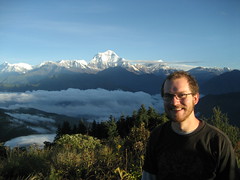
The next day took me over the crest of the hill and back down a knee-jarring (or if you prefer, Nee-jarring) four thousand feet of stairs on my way to Tatopani village, home to a relaxing hot spring plus great guesthouses and restaurants. Over the next few days, the weather turned sour and I marched for a few days in the fog and rain from village to village. Along the way I walked past people carrying massive loads strapped to their foreheads, the most impressive of which was a man carrying two dozen live chickens in an enormous cage with nothing more than his head. I also passed hundreds more soon-to-be-dead goats, which occasionally blocked the path and delayed my journey. On one occasion I had to wait by a bridge for over an hour waiting for a few hundred goats to make it across. I asked one of the herders if I could just cross anyway, even if it scared the goats a bit. “No no no, sir. Goats are dumb. If you scare one and it jumps into the river, they will all jump into the river.” I was disappointed that I even asked — being responsible for such a ridiculous event would have been priceless.
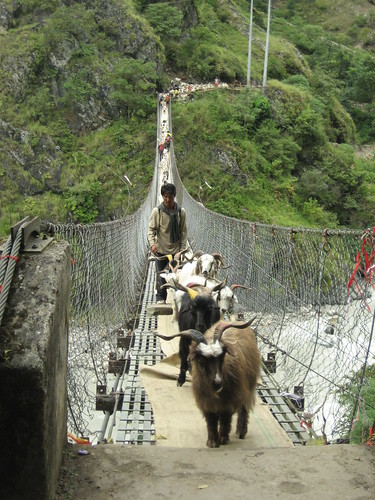
The bad weather spoiled some of the Himalayan views for the next few days as I hiked gradually uphill from Tatopani to Ghasa to Larjung, but the thick fog occasionally led to some cool scenes of its own, like this bridge to nowhere:
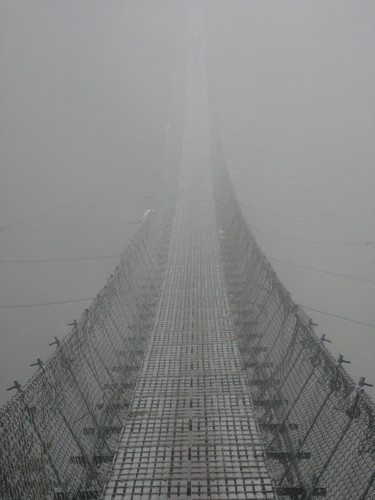
By the way, if looks like the bridge guardrails are only about two feet tall, that’s because they were. Those bridges really get shaking and swinging sometimes, and this one was like standing on a balance beam during an earthquake. It was a bit frightening.
By the seventh day of hiking and I had made it to Nepal’s “Apple Capital,” a village called Marpha which is responsible for growing the majority of the area’s apples. The town sits under mountains that look strikingly like the ones above my hometown Golden, but with a much different scene below: instead of a city there are crumbling stone houses perched along the side of the foothills with narrow streets and alleys that weave through town. It is one of several Thakali villages, which is an ethnic minority that is like a cross between Nepalese and Tibetans, and the village reminded me a lot of Tibet — but with way more apples. I went to a restaurant where I ordered the locally made Marpha Apple Brandy, which tasted a lot more like rubbing alcohol than it did like apples. I also tried the homemade apple pie, which was considerably more delicious, and didn’t make me want to puke like the brandy.
My next stop was the village of Kagbeni set in a desert landscape, which is as close as you can get to the famed Upper Mustang area, which is closed to tourists who don’t cough up the outrageous $700 permit fee. Just a few miles from Tibet, Kagbeni was much more Tibetan than any of the previous villages. I visited the tiny monastery, which turned out to be a highlight of the trek: I entered the one-room building and a monk invited me to sit down with him and listen to the handful of monks rhythmically chanting. I sat for almost an hour with the monks mesmerized by the mood in the room, and even managed to catch some of the sounds with my camera which I hid underneath my leg. After I made my way outside, two monks got on the roof and blew trumpets that echoed all over town.
(sounds of monks chanting coming soon)
(sounds of the trumpets coming soon)
Here’s a shot in the town looking out toward the forbidden Upper Mustang area:
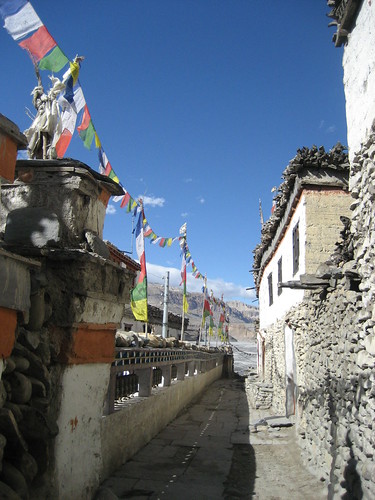
Almost at the end of the trek, I headed up the hill toward the holy city of Muktinath at 12,150 feet which has a temple complex housing a miraculous eternal flame, powered thanks to a natural gas source below ground. The city is a must-visit for Hindus, and is a major pilgrimage center. Most of the devout made the trek for days by foot, but some of the Kathmandu elite opt for the much easier option and chartered a helicopter directly to the temple area. People splashed through the 108 fountains of holy water and donated money to the holy saddhus, who apparently come to Muktinath from as far away as southern India.
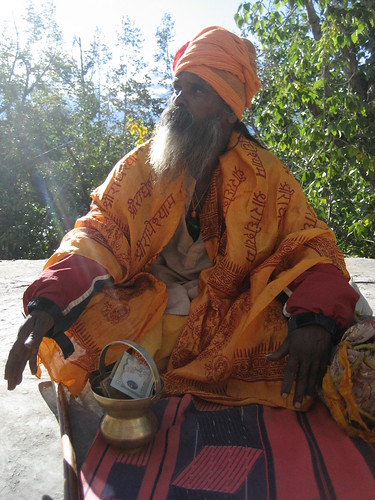
Yesterday, I made the final leg of the trek down the hill to Jomsom, where there is an extremely small airport with daily flights back to Pohkara. Flights get cancelled constantly because the planes have to fly through the Himalayas and as a result they’re not really wild about flying when its foggy. I met some delightful fellow Coloradoans along the trail down to Jomsom who also had plans to fly the next morning, so we all crossed our fingers for good weather. Our last night of the trek was spent drinking beer and brandy, singing songs and dancing with their wonderfully goofy Nepalese guide and porter. Here’s a couple videos of the action:
(video to come)
(video to come)
This morning we woke up early with skies clear and made the one-minute walk to the airport. Once we made it through airport security — about as strict as security at a Rockies game — we made our way out to the frighteningly tiny 16-person plane with the Himalayas in the background:
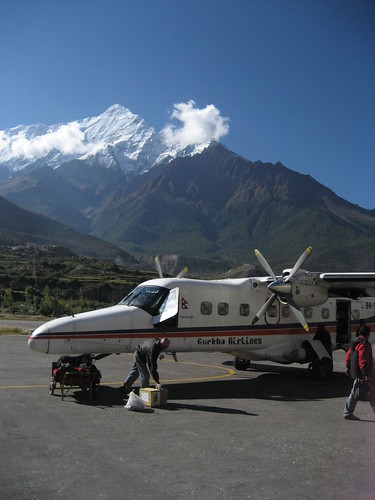
The flight was short and the plane flew unbelievably low to the ground, but it wasn’t as bad as you’d expect from such a little plane. The Coloradoans and I landed back in the warm air of Pohkara where I settled in at my old hotel, took a proper shower, watched a little CNN, and shaved for the first time in almost two months. Now I’m beard-free, preparing to head into hot n’ smoggy India where I’ll likely spend the next couple of months. The scale of my India plans keep getting bigger the more I read about it, so I’m planning on staying for a couple of months, assuming I like it enough to stay for that long. If not, I’ll get out of there and head over to Thailand.
Once I’m on a decent internet connection in India, I’ll upload all of the missing photos and videos from the last month in Nepal. Thanks for your patience!
